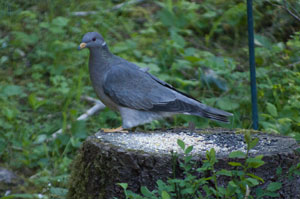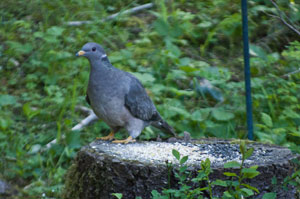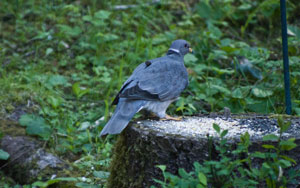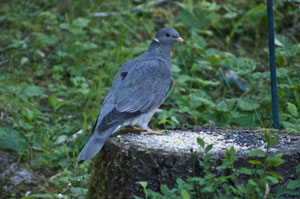Band-tailed Pigeon
patagioenas fasciata
Protonym: columba fasciata

|
| All photos with blue borders expand if clicked |

|

|

|
Though fairly uncommon, this is the largest pigeon in the Northwest. This is a large, ungainly, but actually acrobatic bird. It is purplish-gray in appearance. It has a white streak at the back of its neck with an iridescent patch just beneath that (esp. during mating season) and a faint black band at its tail, for which it is named. It is about 14-15 inches long from beak to tip of the tail. It has a yellow bill and yellow feet, and some black feathers at the end of its wings. It has large, round eyes which give it the innocent appearance that all doves and pigeons have.
The population has dwindled because of over hunting, but it is beginning to recover its numbers due to bans on hunting in some states. It lives at the edge of forests and nests near the tops of Douglas fir trees, oak trees, or other trees. It comes to feeders and birdbaths. It feasts on berries, bird seeds, flowers, and insects. It goes to rock pits, inland salt marshes, or other places where it can find salt for its diet. It is easily startled, and it will fly away quickly at the slightest sound with a loud flapping sound. It loves to perch in the tops of bare trees. You may see small flocks of band-tailed pigeons high in trees or gathering around a bird feeder, generally seen in canyons or high in the mountains. It likes forest edges along open areas. You can see them flying above fields in what I would call maneuvers or flight formations. They are a thrill to watch.
The band-tailed pigeon's nest is a precarious stack of about five inches of sticks. It lays a single, white egg up to three times a year. At first, it feeds the young bird, pigeon's milk (which is produced only by doves and pigeons), then it gives the young regurgitated berries, fruits, and seeds. Both parents incubate the egg for 18-20 days. The young is in the nest about 25-30 days, and then it leaves the nest. The juvenile doesn't have the white streak on the nape of its neck.
This pigeon has a distinct voice. Generally, it goes "whoo, whoo," (like an owl) but it has a slightly different mating call: "whoo ho" or "whoo-uh."
These birds winter in central California, South and Central America. When migrating, they will stay close to the forests and their food sources.
Please note that rock doves (city pigeons) and band-tailed pigeons are easily distinguishable. The band-tailed pigeons all look alike. The rock doves are in all different colors and patterns and are a little smaller than the band-tailed pigeon.
By Martha Van Natta
Avian database of names---This is the reference work for the two Latin Names
Additional information: see Wikpedia - Band-Tailed Pigeon